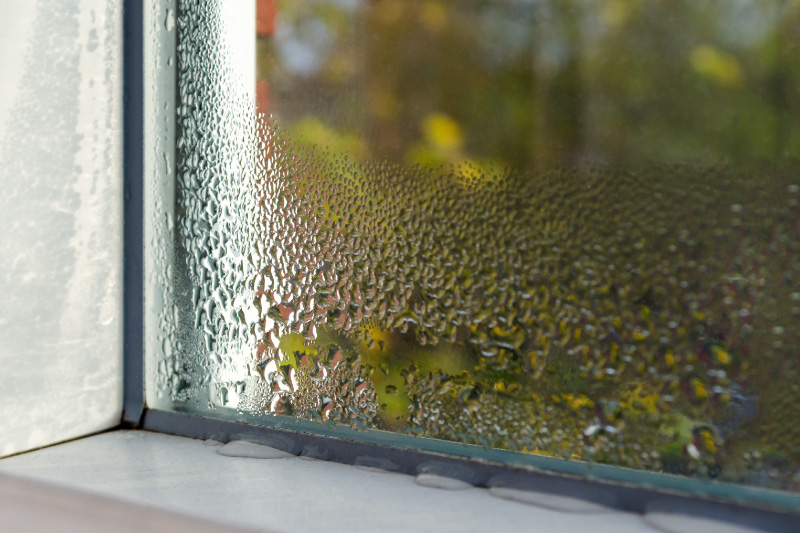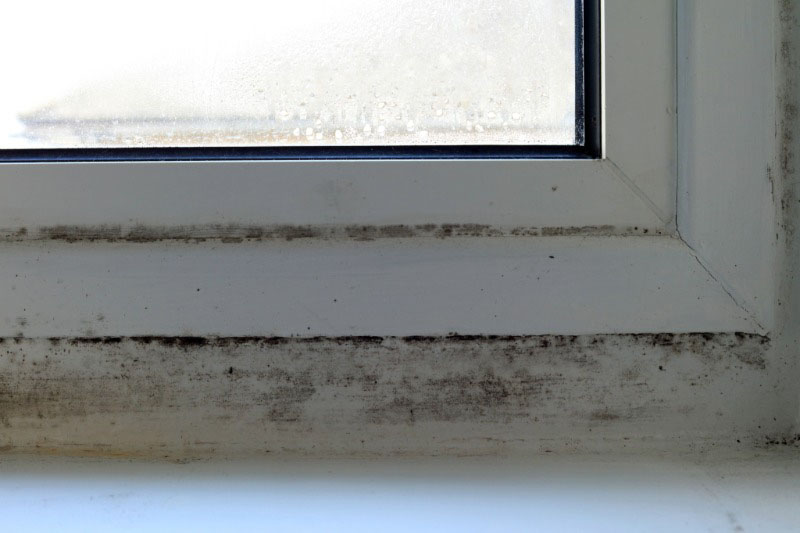Arkansas is known for its lush greenery and welcoming climate, but with that beauty comes one of the biggest challenges for homeowners: humidity. With an average relative humidity of approximately 70–71% and July dew points in Little Rock hovering near 71°F, Arkansas ranks among the top 15 most humid states in the United States. While the moisture in our air keeps landscapes thriving, it also poses serious risks to homes in Arkansas—from structural damage and mold growth to pest infestations and concerns about indoor air quality.
This guide provides proven strategies for protecting your Arkansas home from humidity and moisture issues, with a special focus on insulation, air sealing, ventilation, and other home solutions tailored to our unique climate.
The Dangers of High Humidity
Structural Damage
Excess moisture is one of the greatest threats to a home’s integrity. Over time, high humidity can warp wood framing, rot timber, corrode metal, and weaken drywall or plaster. Foundations and crawl spaces are especially vulnerable in our humid subtropical climate, where warm Gulf air brings abundant moisture. Left unchecked, these issues can lead to costly repairs.

Mold and Mildew
Mold thrives when humidity levels exceed 60%—a threshold Arkansas often surpasses. According to the Arkansas Department of Health, controlling indoor moisture is the most critical factor in preventing mold growth. Mold can develop on damp surfaces within 24–48 hours, causing musty odors, staining, and potentially serious health risks for residents.
Pests
Arkansas humidity is also a beacon for termites, cockroaches, and dust mites. Subterranean termites require moisture to survive, while cockroaches are drawn to damp, dark spaces. By reducing indoor humidity, homeowners make their spaces less appealing to these destructive and unhealthy invaders.
Health Concerns
Excess humidity directly affects indoor air quality. Dust mites multiply rapidly when humidity exceeds 50%, triggering allergies and asthma. Mold spores can also worsen respiratory conditions. High humidity makes indoor air feel heavy, placing extra strain on those with breathing issues. Experts recommend maintaining humidity levels between 30% and 50% for optimal comfort and health.
How Temperature Affects Indoor Humidity
Humidity and temperature are inseparable. Warm air holds more moisture, so when humid Arkansas air encounters cooler surfaces, such as walls, single-pane windows, or pipes, condensation forms. This can lead to mold growth, water stains, and long-term structural issues.

Even air conditioning systems can contribute to the problem if they’re oversized. Units that cool air too quickly often fail to remove humidity effectively. Proper insulation, storm windows, and balanced HVAC systems ensure indoor temperatures and surfaces remain steady, reducing condensation risks.
Insulation: Your First Line of Defense
One of the most effective tools for mitigating humidity risks is proper insulation, combined with effective air sealing. Insulation prevents warm, moist air from infiltrating, while air sealing blocks leaks that let humidity seep inside. Together, they create an energy-efficient and moisture-resistant barrier.
Attic Insulation
Because heat rises, attics are a hotspot for moisture problems. High R-value attic insulation with vapor retarders helps slow moisture diffusion, prevents condensation, and reduces the “greenhouse effect” in the attic. Aim for R-38 or higher insulation in Arkansas attics, and ensure attic vents are clear.
Wall Insulation
Exterior walls need insulation to protect against both heat transfer and excess humidity. By sealing gaps around sheathing and windows, homeowners reduce the risk of moist air condensing inside walls, where hidden mold can develop. Retrofit options, such as blown-in cellulose or spray foam insulation, are excellent choices for older homes.
Crawl Space and Basement Insulation
Crawl spaces and basements are notorious for being moisture-prone zones in Arkansas. Groundwater evaporates upward, feeding humidity indoors. Installing a plastic vapor barrier, insulating crawl space walls, and sealing the area dramatically reduces moisture intrusion. Spray foam insulation is a smart solution because it both insulates and air-seals, preventing wood rot and mold.
Additional Moisture Prevention Tips
Improve Ventilation
Proper ventilation is crucial for reducing indoor humidity and maintaining a healthy indoor environment. Use exhaust fans in bathrooms, kitchens, and laundry rooms, and always vent them directly outside, never into the attic. Run bathroom fans during showers and for at least 20 minutes afterward to help remove excess moisture. In the kitchen, use your range hood whenever you are boiling or steaming food, and ensure that your dryer vents outdoors.
You can also improve airflow naturally. Create cross-breezes by opening windows on opposite sides of your home during drier, cooler times of day, such as late morning or after sunset. Avoid opening windows on hot, muggy days, which can increase indoor humidity. The key is to ventilate smartly, allowing fresh air in only when outdoor humidity levels are lower than those indoors.
Use Dehumidifiers
When natural or mechanical ventilation isn’t enough, a dehumidifier may be your best defense against excess moisture. Whole-house dehumidifiers integrate with your HVAC system to control humidity throughout the entire home, while portable models are ideal for particularly damp areas, such as basements, crawl spaces, or laundry rooms. Dehumidifiers physically remove moisture from the air, and running one is often necessary during Arkansas summers.
The Arkansas Allergy and Asthma Clinic recommends maintaining indoor humidity levels between 40–50% to minimize allergens and mold. Set your humidistat to 50%. Remember to empty or drain the water reservoir regularly and clean the filters for optimal performance. The EPA also recommends using dehumidifiers and air conditioning systems in hot, humid regions, such as Arkansas, to maintain a safe and comfortable environment.

Seal Gaps and Cracks
Even small air leaks can allow surprising amounts of humid air to enter. Air sealing is critical for both moisture control and energy efficiency. Check common problem areas such as windows, doors, electrical outlets, plumbing penetrations, recessed lights, and wall-to-attic junctions.
Use caulk or weatherstripping for smaller gaps and expanding spray foam for larger openings. These minor improvements can prevent humid outdoor air from entering your home, helping your HVAC system work more efficiently and resulting in lower utility bills year-round.
Manage Water and Leaks
With Arkansas averaging around 50 inches of rain annually, effective water management is essential. Maintain your roof, gutters, and downspouts to ensure proper drainage. Use gutter extensions or splash blocks to carry water 3–6 feet away from your foundation, and make sure the ground slopes outward from the perimeter of your home.
Check for plumbing leaks, dripping pipes, or roof damage, and address any issues immediately, as even small drips can lead to significant moisture accumulation over time. Conduct periodic inspections under sinks, in attic eaves, and around basement corners. If flooding occurs, dry affected areas within 24–48 hours to prevent mold growth. Quick action is crucial to minimize damage and preserve indoor air quality.
Conduct Regular Inspections
A proactive approach to moisture management helps catch problems before they become expensive repairs. Inspect your home at least twice a year, especially before and after Arkansas’s most humid seasons, spring and fall.
Look for water stains, discoloration, peeling or bubbling paint, musty odors, or condensation on windows and walls. Check crawl spaces, attics, and behind appliances, where moisture problems often hide. Consider using a moisture meter to test walls and wooden beams. Regular inspections help identify minor issues early, offering peace of mind and preserving your home’s long-term integrity.
Keep Moisture Out and Comfort In
Living in Arkansas, humidity doesn’t have to mean living with excess moisture. By combining insulation, air sealing, proper ventilation, and regular maintenance, you can keep your home safe, healthy, and energy efficient. Maintaining humidity between 30% and 50% discourages mold, dust mites, and pests, while improving comfort and indoor air quality.
At G&S Insulating, we specialize in helping homeowners across Little Rock, Springdale, and Jonesboro protect their homes from humidity and moisture problems. From attic insulation and crawl space encapsulation to spray foam and air sealing, our expert team offers tailored solutions for Arkansas’s climate.
Contact us today for a free estimate and discover how we can keep moisture out and comfort in for years to come.
References
Arkansas Allergy and Asthma Clinic. (n.d.). Does humidity affect allergies & asthma? https://arallergy.com/blog/allergies/does-humidity-affect-allergies-asthma/
Arkansas Department of Health. (n.d.). Mold [Fact sheet]. https://healthy.arkansas.gov/wp-content/uploads/Resources_-_Fact_Sheets_-_Mold.pdf
Daily Passport. (n.d.). Most humid states in America. https://dailypassport.com/most-humid-states-america/
Encyclopedia of Arkansas. (n.d.). Climate and weather. https://encyclopediaofarkansas.net/entries/climate-and-weather-4579/
Fox Weather. (n.d.). Termite protect season home. https://www.foxweather.com/learn/termite-protect-season-home
Harrison’s Original Khoz. (n.d.). The facts about molds in indoor environments. https://www.harrisonsoriginalkhoz.com/news/news/suggested-for-you/the-facts-about-molds-in-indoor-environments/
University of Arkansas Housing. (n.d.). Air quality. In Residential facilities handbook (Section 5.10). https://encyclopediaofarkansas.net/entries/climate-and-weather-4579/
U.S. Environmental Protection Agency. (n.d.). What are the main ways to control moisture in your home? https://www.epa.gov/mold/what-are-main-ways-control-moisture-your-home
World Population Review. (n.d.). Most humid states. https://worldpopulationreview.com/state-rankings/most-humid-states
